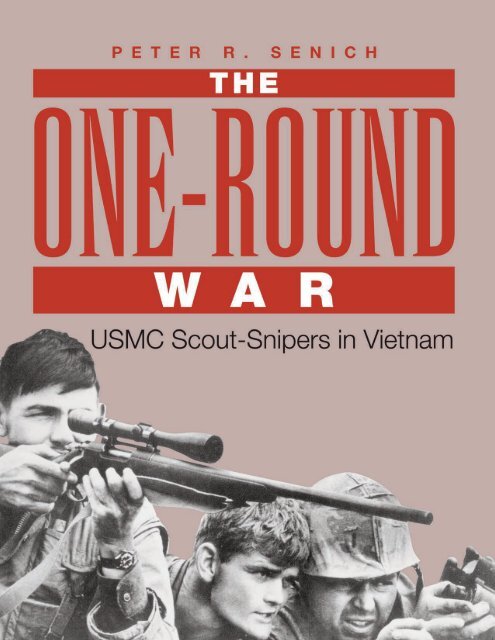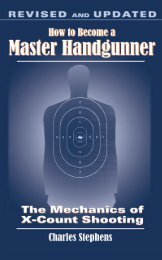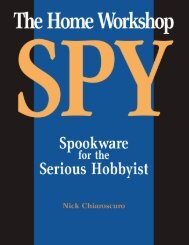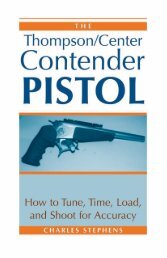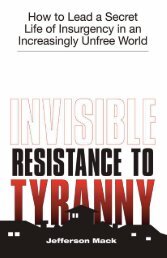The One-Round War: USMC Scout-Snipers in Vietnam - Paladin Press
The One-Round War: USMC Scout-Snipers in Vietnam - Paladin Press
The One-Round War: USMC Scout-Snipers in Vietnam - Paladin Press
- No tags were found...
You also want an ePaper? Increase the reach of your titles
YUMPU automatically turns print PDFs into web optimized ePapers that Google loves.
CHAPTER 7SNIPERPLATOONA Good Example<strong>The</strong> <strong>Vietnam</strong> experiences of M.Sgt. William D. Abbott, <strong>USMC</strong> (Ret.),the Third Mar<strong>in</strong>es <strong>Scout</strong>-Sniper Platoon Commander (25 December1966–14 October 1967), provide valuable <strong>in</strong>sight <strong>in</strong>to one Mar<strong>in</strong>e regiment’sefforts to employ <strong>Scout</strong>-<strong>Snipers</strong> to its best advantage.<strong>The</strong> problems encountered and the measures necessary to pull theThird Mar<strong>in</strong>es snip<strong>in</strong>g program together are <strong>in</strong>dicative of the difficultiesMar<strong>in</strong>es like Bill Abbott faced <strong>in</strong> <strong>Vietnam</strong>. As the Corps was quick to learn,tra<strong>in</strong><strong>in</strong>g snipers was one th<strong>in</strong>g; employ<strong>in</strong>g them effectively was anotherproblem altogether and the key to successful sniper operations.<strong>The</strong> discipl<strong>in</strong>e required of a successful match shooter was one of themajor reasons for the use of competitive marksmen as the organizationalfoundation of the Mar<strong>in</strong>e Corps snip<strong>in</strong>g program <strong>in</strong> <strong>Vietnam</strong>. In this case,however, rather than be<strong>in</strong>g an accomplished rifle and/or pistol shooter, asmost of the Mar<strong>in</strong>es <strong>in</strong>volved with the sniper program were, SergeantAbbott had earned the title of “Dist<strong>in</strong>guished International Shooter” for histrapshoot<strong>in</strong>g skills before he was posted to Southeast Asia.<strong>The</strong> pr<strong>in</strong>cipal arteries <strong>in</strong> the I Corps Tactical Zone, the Mar<strong>in</strong>e Corpsarea of responsibility <strong>in</strong> RVN, were Routes 1, 4, and 9. Camp Carroll, theHeadquarters for Third Mar<strong>in</strong>es, was located on Route 9 approximately 12miles west of Dong Ha <strong>in</strong> Quang Tri Prov<strong>in</strong>ce. <strong>The</strong> camp was situatedabout 6 miles south of the demilitarized zone (DMZ).105
THE ONE-ROUND WARThough barely a dirt trail for much of its length, Route 9 passed through, or <strong>in</strong> close proximity to,such places as Cam Lo, <strong>The</strong> Rockpile, Ca Lu, Khe Sanh, and Lang Vei on its way to the Laotian border.For the Mar<strong>in</strong>es who were there, these were names and places not likely to be forgotten.Bill Abbott describes <strong>in</strong> his own words the activities of Third Mar<strong>in</strong>es <strong>Scout</strong>-Sniper Platoon dur<strong>in</strong>g1967 as follows:When I arrived at Camp Carroll <strong>in</strong> the Republic of South <strong>Vietnam</strong> onChristmas Day 1966, I was assigned to Headquarters 3rd Mar<strong>in</strong>es. On report<strong>in</strong>g Iwas assigned the duty of Platoon Commander of the 3rd Mar<strong>in</strong>e <strong>Scout</strong>-<strong>Snipers</strong>. Iwas <strong>in</strong>structed to report to Regimental Commander Colonel John P. Lanigan.<strong>The</strong> colonel <strong>in</strong>formed me that their “snipers were scattered from hell to breakfast”and “were not be<strong>in</strong>g used for what they were tra<strong>in</strong>ed to do.” He said he wouldgive me “just 30 days” to round them all up; retra<strong>in</strong> and refit them for duty as <strong>Scout</strong>-<strong>Snipers</strong>. <strong>The</strong> colonel wanted a unit he could call on to plug the holes as needed.As I went to the various companies <strong>in</strong> the regiment I found the snipers be<strong>in</strong>gused on mess duty, guard duty, burn<strong>in</strong>g and every other dirty task that needed tobe done.<strong>One</strong> of the company commanders who had a two-man team assigned to himtold me “I don’t give a damn who you are, you don’t get these men until they areoff mess duty.” I asked to use his field phone and he said “go right ahead, call anybodyyou want to, but you aren’t gett<strong>in</strong>g them.” I told the phone operator to call“Starboard 6” (Col. Lanigan), and when the “6” came on the l<strong>in</strong>e I stated my problem.He said to put the company commander on the phone. I handed the companycommander the phone and told him “Starboard 6” wanted to talk to him. He turnedwhite as he took the phone and didn’t have much to say except “Yes Sir, Yes Sir, Iunderstand Sir, I’m sorry Sir.” When he got off the phone he told his lst Sergeant toget those men to regimental headquarters on the double. He then turned to me andsaid “I owe you one.”While assembly of the snipers was go<strong>in</strong>g on, I had my Platoon Sergeant andsquad leaders putt<strong>in</strong>g together a tra<strong>in</strong><strong>in</strong>g program that <strong>in</strong>cluded a refresher course<strong>in</strong> all aspects of <strong>Scout</strong>-Sniper duties. We set up a long distance range and conducteddawn till dusk shoot<strong>in</strong>g practice for a m<strong>in</strong>imum of 6 hours per day. <strong>The</strong> tra<strong>in</strong><strong>in</strong>g<strong>in</strong>cluded hand-to-hand combat, physical exercise, the use of radios for artillery andair-strikes, map read<strong>in</strong>g, etc.With tra<strong>in</strong><strong>in</strong>g set, I took a squad leader, rations for 15 days, maps of ourentire A.O., and we went on a scout mission from Camp Carroll east to the ocean.We moved at night, slept a little, and studied the terra<strong>in</strong> dur<strong>in</strong>g the day. When wereached the ocean north of Dong Ha we crossed the Ben Hai River and proceededwest <strong>in</strong> the DMZ to Laos. We crossed the river to the south side of the DMZ andmade our way back to Camp Carroll.<strong>The</strong>re were several reasons for this trip:1. To learn the A.O. we would be work<strong>in</strong>g <strong>in</strong>.2. I took plastic play<strong>in</strong>g cards with me to prove to my troops that I had beenthere. <strong>The</strong> cards were hidden <strong>in</strong> fairly easy locations so that the patrol leaders couldf<strong>in</strong>d them. I would sign a card, date it, hide it, and mark the location on my map. <strong>The</strong>patrol was told the location of the card, but not which card it was. When they found itthey knew damn well I had been there. <strong>The</strong> former platoon commander would notgo on patrol, nor did he check on the men assigned to the <strong>in</strong>fantry companies.106
SNIPER PLATOON3. To locate the routes the NVA were us<strong>in</strong>g to head south.4. To determ<strong>in</strong>e the best locations to set up <strong>in</strong>terdiction teams.After the tra<strong>in</strong><strong>in</strong>g was completed and the sniper weapons were brought up toas good a condition as they could be, we were assigned the task of clear<strong>in</strong>gsnipers (“the bad guys”) from Route 9 from Dong Ha to Khe Sanh. Our convoyswere tak<strong>in</strong>g sniper fire on a regular basis.We set up a system consist<strong>in</strong>g of two <strong>Scout</strong>-Sniper teams <strong>in</strong> two jeeps with asquad leader and radio operator that would work together as a team. We formed atotal of 10 teams and stationed them as follows; 2 at Khe Sanh, 1 at <strong>The</strong> Rockpile,4 at Camp Carroll, 1 at Cam Lo, and 2 at Dong Ha. When a shot was fired at a convoywe responded from the east and west of the convoy and sent an additional 2teams from Camp Carroll. <strong>The</strong> way this was set up we could have a team respond<strong>in</strong> not more than 30 m<strong>in</strong>utes anywhere along Route 9. This worked very well andwe secured the road from enemy sniper fire.Dur<strong>in</strong>g this time I also visited our battalion and company commanders andgave each one a run-down on the best way to employ <strong>Scout</strong>-Sniper teams. Thisturned out to be a nearly full-time job due to combat <strong>in</strong>juries and rotation of officers.It proved to be worthwhile, however. When teams were assigned to go witha battalion or company on a combat sweep, <strong>in</strong> most cases, the snipers were usedcorrectly and effectively.<strong>The</strong> major problems we had to overcome were:1. Be<strong>in</strong>g treated like a bastard at a family reunion. No one wanted to beresponsible for our equipment or rations.2. <strong>The</strong>re was no school<strong>in</strong>g at company or higher level on proper employmentof <strong>Scout</strong>-<strong>Snipers</strong>.3. All of this was tak<strong>in</strong>g place when the Corps was really just start<strong>in</strong>g to gearup <strong>in</strong> RVN.For all of the difficulties we experienced, however, with the help of ColonelLanigan and the S-3, th<strong>in</strong>gs did improve a great deal before I left <strong>in</strong> October 1967.We received the Rem<strong>in</strong>gton M700s with the 3-9 scopes, the AR15, and StarlightScopes as well.<strong>The</strong> rotation of snipers with two-thirds <strong>in</strong> the field and one-third be<strong>in</strong>g held<strong>in</strong> reserve for rest and refit worked very well. We relieved one-third every 30 dayswhich meant 60 days <strong>in</strong> the field and 30 days R&R. When the troops came <strong>in</strong> forR&R they cleaned their equipment first and the rest came after that. While theywere <strong>in</strong> base camp they were subject to be<strong>in</strong>g called out for Route 9 patrol or anyother problem that came up.I had 20 months combat <strong>in</strong> Korea as a squad leader and platoon sergeant andI had some very good men. I do believe the special tra<strong>in</strong><strong>in</strong>g the <strong>Scout</strong>-<strong>Snipers</strong> hadgone through gave them a better edge, that is, the men were tra<strong>in</strong>ed for known missionsand were equipped to carry out the missions both mentally and physically.<strong>The</strong>se were the most highly motivated Mar<strong>in</strong>es I had ever commanded <strong>in</strong>combat. I am <strong>in</strong>deed a very lucky man to have had that honor. <strong>The</strong>y were the best!<strong>The</strong> official position regard<strong>in</strong>g the Sniper Platoon was set forth <strong>in</strong> “Division Order 3590.3A,” 5 July107
THE ONE-ROUND WAR1967. <strong>The</strong> order “promulgated <strong>in</strong>structions and <strong>in</strong>formation concern<strong>in</strong>g the activities of Sniper Platoonswith<strong>in</strong> the 3d Mar<strong>in</strong>e Division.”As it was then stated:Policya. <strong>The</strong> unique capabilities of the <strong>Scout</strong>-Sniper Platoon are at the disposalof the Regimental and/or battalion commanders. <strong>The</strong> platoon may beemployed as a unit, or it can be broken down <strong>in</strong>to squads or teams whichmay be attached to any size tactical unit of the regiment/battalion.b. <strong>Snipers</strong> should wherever possible, be employed <strong>in</strong> pairs to m<strong>in</strong>imizeeye fatigue from <strong>in</strong>cessant surveillance. <strong>The</strong> two members relieveeach other <strong>in</strong> perform<strong>in</strong>g the duties of sniper and observer.c. A squad (10–14 Mar<strong>in</strong>es) built around a Sniper team is generallyconsidered as the smallest unit which should be employed on missionsbeyond sight or direct communications from parent units. However, wherethe situation, terra<strong>in</strong>, and reaction capability permits the commander toreduce this force to exploit stealth and surprise, the calculated employmentof smaller groups (4–8 Mar<strong>in</strong>es) is authorized out to 2,000 meters fromfriendly positions. <strong>The</strong>se forces may be made up primarily or even exclusivelyof scout/sniper personnel provided appropriate arms and equipmentaugmentation is provided. Aga<strong>in</strong> with appropriate situation, terra<strong>in</strong> andreaction capability commanders are also authorized to employ s<strong>in</strong>glescout-sniper teams out to 500 meters from friendly positions.d. Under all conditions of employment scout-sniper teams/units willbe provided with appropriate communications, artillery and mortar firesupport on an “on-call” basis.e. RTE armorers, MOS 2112, will be the only armorers authorized toperform second echelon ma<strong>in</strong>tenance. Weapons and telescopes requir<strong>in</strong>gthird echelon ma<strong>in</strong>tenance will be evacuated to FLSG.Mission. <strong>The</strong> mission of the <strong>Scout</strong>-Sniper Platoon is to support theInfantry/Reconnaissance Battalions by provid<strong>in</strong>g a specially tra<strong>in</strong>ed andequipped unit capable of render<strong>in</strong>g sniper support <strong>in</strong> combat operations,by provid<strong>in</strong>g personnel tra<strong>in</strong>ed to kill <strong>in</strong>dividual enemy soldiers with s<strong>in</strong>glerifle shots from positions of concealment.Organization. Reference (b) [Allocation Change Number 753-65] promulgateddetailed <strong>in</strong>structions concern<strong>in</strong>g the organization of the <strong>Scout</strong>-Sniper Platoon with<strong>in</strong> the Infantry Division.a. Infantry Regiment organization consists of 3 squads of 5 two-manteams and a squad leader each, an NCOIC, an RTE armorer and an Officer-In-Charge with a total strength of 1 officer and 35 enlisted.108
SNIPER PLATOONb. <strong>The</strong> Reconnaissance Battalion organization consists of 4 squads of3 two man teams and a squad leader each, an NCOIC, an RTE armorer andan Officer-In-Charge with a total strength of 1 officer and 30 enlisted.Considerations for Employmenta. Conventional Offensive(1) <strong>The</strong> capability of snipers to support <strong>in</strong>fantry offensive actionby precision destructive/neutraliz<strong>in</strong>g fire is <strong>in</strong>valuable. <strong>Snipers</strong> withtelescopes have the dist<strong>in</strong>ct advantage of be<strong>in</strong>g able to see as much asn<strong>in</strong>e times better (with a 9x scope) than the <strong>in</strong>fantry personnel be<strong>in</strong>gsupported. Neutralization of enemy automatic weapons and defensivepositions is facilitated by the utilization of optics. As advanc<strong>in</strong>g <strong>in</strong>fantryelements cont<strong>in</strong>ue <strong>in</strong> the advance, snipers must displace to forwardechelon to effectively support the offense by fire. Depend<strong>in</strong>g upon thesize of the objective, snipers may be massed to render proportionatelymore support. Upon seizure of the objective, pursuit by fire phase isenhanced by the presence of snipers.b. Conventional Defensive(1) <strong>The</strong> effective range and optical advantage of sniper rifles used<strong>in</strong> defensive situations causes premature deployment of enemy elementsand unquestionably creates a tremendous psychological, demoraliz<strong>in</strong>gimpact upon the enemy. Officers, NCO’s and crew-served weapons arelikely targets. Variable telescopes with magnification at low power possessthe capability of acquir<strong>in</strong>g targets at ranges up to 600 meters when a fullmoon is evident, over rice paddies. While the ability to penetrate heavyfoliage and tree l<strong>in</strong>es is limited, dist<strong>in</strong>ct objects such as monuments,pagodas, etc. may be identified. Conventional iron sights do not have thiscapability. With telescopic sights, an additional hour of effective shoot<strong>in</strong>gtime with accuracy, is possible. This capability denies the enemymovement dur<strong>in</strong>g first light and at dusk.c. Attachment to Patrols(1) Experience has shown that the Viet Cong <strong>in</strong>variably takepatrols under small arms fire from concealment. Fir<strong>in</strong>g is sporadic, of shortduration, and because of the dense foliage it is extremely difficult to detectthe source. <strong>Snipers</strong>, attached to patrols, with telescopic sights have thecapability of acquir<strong>in</strong>g targets more readily than other patrol memberswithout benefit of optics. Additionally, their long range accuracy deniesthe enemy the ability to close and therefore m<strong>in</strong>imizes the accuracy of theweapons. In built up areas, targets frequently cannot be taken under fireby area type weapons because of the proximity of <strong>in</strong>nocent civilians. <strong>The</strong>capability of the sniper <strong>in</strong> deliver<strong>in</strong>g precision, long range fire is atremendous asset to the patrol.109
THE ONE-ROUND WARd. Daylight Ambush - Extended(1) This type employment is used <strong>in</strong> selected areas where there is alikelihood of encounter<strong>in</strong>g Viet Cong. <strong>The</strong> concept of employment providesfor the sniper team, with <strong>in</strong>fantry protection mov<strong>in</strong>g to a pre-selectedambush site under cover of darkness and be<strong>in</strong>g <strong>in</strong> position by first light.Surveillance is ma<strong>in</strong>ta<strong>in</strong>ed throughout the day. Withdrawal is madeafter darkness. <strong>Snipers</strong>, with the dual capability of adjust<strong>in</strong>g artillery fire,take identifiable targets under fire with artillery or sniper rifle depend<strong>in</strong>gupon the size of the target. Survivors of observed artillery missions aretaken under fire by the sniper.e. Daylight Ambush - Close(1) Close ambushes are those sniper team ambushes with<strong>in</strong>approximately 300 meters of friendly positions. To avoid possible captureor destruction the sniper team is covered by friendly fires. <strong>The</strong> 300 meters,coupled with the 1000 meter range of the weapon theoretically denies theenemy movement with<strong>in</strong> 1300 meters of friendly positions and accord<strong>in</strong>glym<strong>in</strong>imizes the effect of enemy sniper fire and surveillance. This type ofemployment also <strong>in</strong>volves assumption of the pre-selected ambush siteprior to daybreak and withdrawal after darkness has followed.f. Counter-Sniper(1) In situations where<strong>in</strong> friendly positions receive small arms fireon successive days from the same general location, snipers are employedto decrease the enemy’s effectiveness by deliver<strong>in</strong>g accurate counter-sniperfire. <strong>The</strong> dist<strong>in</strong>ct advantage lies <strong>in</strong> the sniper weapons precision firecapability when fir<strong>in</strong>g <strong>in</strong>to built-up areas which normally precludes theutilization of automatic weapons or support<strong>in</strong>g arms.g. Block<strong>in</strong>g Positions(1) Sniper teams attached to <strong>in</strong>fantry elements <strong>in</strong> block<strong>in</strong>gpositions have been used extensively and effectively <strong>in</strong> conjunction withsearch and destroy operations. <strong>The</strong> enemy is taken under fire when driven<strong>in</strong>to the block<strong>in</strong>g positions or while attempt<strong>in</strong>g to evade capture. <strong>The</strong>sniper rifle’s accuracy, range and telescopic sights permit long range firesat targets which normally are too far distant to allow positive identification.This capability, <strong>in</strong> effect, precludes <strong>in</strong>discrim<strong>in</strong>ate fir<strong>in</strong>g at <strong>in</strong>nocent<strong>in</strong>digenous who have <strong>in</strong>advertently wandered <strong>in</strong>to the area of operations.Employment of Attached <strong>Snipers</strong>a. Employment of snipers <strong>in</strong> both an offensive and defensive role isgenerally limited only by the imag<strong>in</strong>ation. Types of employment for whichsnipers are suitably equipped and tra<strong>in</strong>ed are as follows:110
(1) Execution of long range (500–1000 meters) daylight ambushes.(a) To kill and harass the enemy by precision fire.(b) Strik<strong>in</strong>g fear <strong>in</strong> the enemy by the psychological aspectsderived from long range accurate small arms fire.(2) Daylight patrols - Provided the terra<strong>in</strong> is suitable for long rangeaccurate fire <strong>in</strong> support of patrol activities.(3) Block<strong>in</strong>g forces - Cover likely avenues of escape.(4) Offense(a) Provide accurate cover<strong>in</strong>g fire for advanc<strong>in</strong>g maneuverelements.(b) Attack prime targets such as: crewserved weapons, bunkerapertures and personnel <strong>in</strong> trench l<strong>in</strong>es or fight<strong>in</strong>g holes.(c) Pursue enemy by long range fire(5) DefenseSNIPER PLATOON(a) Take enemy under fire at distances up to 1000 meters withaccuracy.(b) Deny the enemy freedom of movement <strong>in</strong> approach tofriendly positions.(c) Counter-sniper fire - decrease enemy effectiveness throughaccurate counterfire.b. Supported Unit Requirements. Units employ<strong>in</strong>g sniper teams must<strong>in</strong>sure that the follow<strong>in</strong>g pr<strong>in</strong>ciples are adhered to <strong>in</strong> employ<strong>in</strong>g snipers:(1) Always employ <strong>in</strong> teams (pair) to <strong>in</strong>crease their capability.(2) Always cover by a security element (one fire team and a radiooperator).(3) Do not employ as a security element to front, rear, or flanks <strong>in</strong>column movements.(4) Do not employ <strong>in</strong> ambushes, patrols or listen<strong>in</strong>g posts dur<strong>in</strong>gthe hours of darkness.(5) Always <strong>in</strong>sure snipers are <strong>in</strong>formed of any friendly forceswith<strong>in</strong> their operat<strong>in</strong>g area.111
THE ONE-ROUND WARc. Control of Teams(1) Units desir<strong>in</strong>g sniper team augmentation submit request to thisHeadquarters. Request to <strong>in</strong>clude number of teams desired and estimatedduration of utilization.(2) Sniper Platoon personnel when deployed will be under theOPCON of the supported unit and under ADCON of HeadquartersCompany Regiment. <strong>The</strong> supported unit will provide logistical support tosniper personnel under their OPCON.Reportsa. Units participat<strong>in</strong>g <strong>in</strong> normal operations <strong>in</strong>clude the follow<strong>in</strong>g<strong>in</strong>formation <strong>in</strong> 1800 SITREP to cover the period 0001-2400H that day.b. Units submitt<strong>in</strong>g 24 hour SITREPS <strong>in</strong>clude the follow<strong>in</strong>g<strong>in</strong>formation for consolidation <strong>in</strong>to Division Daily SITREP.c. Format & ExampleMethod ofCMD GRU/OP No. of Teams No. Deployed Employment ResultsA/1/4 3 2 Outpost 1VCSecurity KIAd. Additionally, a copy of enclosure (1) [Sniper Report Form] will beforwarded to this Headquarters on a weekly basis for evaluation of <strong>Scout</strong>-Sniper teams.Actiona. Command<strong>in</strong>g Officers will implement the <strong>in</strong>structions conta<strong>in</strong>edwith<strong>in</strong> this order upon receipt.b. <strong>The</strong> Assistant Chief of Staff (G-3 Tra<strong>in</strong><strong>in</strong>g) will provide staffcognizance of the <strong>Scout</strong>-Sniper Platoon performance andquestions/problems will be directed to this Headquarters as they occur.c. A copy of this order will be placed <strong>in</strong> the Commanders Cont<strong>in</strong>uity file.In addition to his duties as platoon commander, while serv<strong>in</strong>g with Third Mar<strong>in</strong>es, Sergeant Abbott<strong>in</strong>itiated a highly successful civic action program for the <strong>Vietnam</strong>ese and Montagnard children <strong>in</strong> theThird Mar<strong>in</strong>es’ Tactical Area of Responsibility. <strong>The</strong> program, named Operation Red Wagon, wasdescribed as follows <strong>in</strong> the January 1968 issue of Trap & Field magaz<strong>in</strong>e:Operation Red Wagon is a program begun <strong>in</strong> May 1967 by the Amateur112
SNIPER PLATOONTrapshoot<strong>in</strong>g Association to encourage the <strong>Vietnam</strong>ese people to be selfsufficient,healthy <strong>in</strong>dividuals and to help our boys <strong>in</strong> <strong>Vietnam</strong>. <strong>The</strong> program wasconceived by MSgt Bill Abbott (our ATA man <strong>in</strong> <strong>Vietnam</strong> at the time) and then-ATA President Ralph Taylor.<strong>The</strong> goal of 1000 red wagons—awarded to <strong>Vietnam</strong>ese children on the basis ofachievement <strong>in</strong> schools and also offered as <strong>in</strong>centives for families <strong>in</strong> crowdedrefugee areas to ma<strong>in</strong>ta<strong>in</strong> high standards of personal cleanl<strong>in</strong>ess and hygiene—wasreached <strong>in</strong> November 1967. When it became apparent that the enthusiasm andefforts on the part of trapshooters would carry the fund over the $4000 goal, the ATAchecked with Bill Abbott and asked, “What else can we offer the kids that will doyou and them a lot of good?” <strong>The</strong> answer was obvious to Bill: “Blue bib overalls—coveralls. <strong>The</strong> k<strong>in</strong>d every kid <strong>in</strong> the United States has. Many of these little ones don’thave anyth<strong>in</strong>g to wear. And it’s hard to go to school under these circumstances.”Though it is rarely noted by the media, there was considerably more to American <strong>in</strong>volvement <strong>in</strong>Southeast Asia than death and destruction. <strong>The</strong> efforts of Bill Abbott are just one example.•••“<strong>The</strong>re were 77,729 Mar<strong>in</strong>es <strong>in</strong> South <strong>Vietnam</strong> at the end of 1967.”—United States Mar<strong>in</strong>e CorpsBrigadier General Metzger (left) and Master Sergeant Abbott, Camp Carroll, 1967. <strong>The</strong>Command<strong>in</strong>g General, N<strong>in</strong>th Mar<strong>in</strong>e Amphibious Brigade, Metzger became assistantdivision commander, 3d MarDiv, <strong>in</strong> May 1967. Sergeant Abbott served as Third Mar<strong>in</strong>es<strong>Scout</strong>-Sniper Platoon Commander (25 December 1966–14 October 1967). Said Abbott,“Even generals got their faces dirty <strong>in</strong> <strong>Vietnam</strong>.” <strong>The</strong> photograph was taken immediatelyafter a Viet Cong mortar attack. Both Mar<strong>in</strong>es were as close to the ground as they couldget. (William D. Abbott.)113
THE ONE-ROUND WARThird Mar<strong>in</strong>e Regiment (3d MarDiv) <strong>Scout</strong>-Sniper personnel shown “sight<strong>in</strong>g-<strong>in</strong>” theirequipment near Camp Carroll. <strong>The</strong> rifles are Model 70 W<strong>in</strong>chesters with 8-power Unertltelescopes. (William D. Abbott.)<strong>The</strong> Commandant of the Mar<strong>in</strong>e Corps Gen. Wallace M. Greene Jr. (left) and Third Mar<strong>in</strong>eRegiment Commander Col. John P. Lanigan are shown dur<strong>in</strong>g an <strong>in</strong>spection tour ofCamp Carroll (1967). Note the 175mm powder canisters l<strong>in</strong><strong>in</strong>g the path. Accord<strong>in</strong>g toMar<strong>in</strong>e Corps <strong>in</strong>formation, at one po<strong>in</strong>t “there were 14 U.S. Army 175mm long-rangeguns [support artillery] operat<strong>in</strong>g from Camp Carroll.” <strong>The</strong> area was also referenced as“Artillery Plateau” <strong>in</strong> Army and Mar<strong>in</strong>e Corps documents. (William D. Abbott.)114
SNIPER PLATOONMembers of the ThirdMar<strong>in</strong>es Sniper Platoon,February 1967. <strong>The</strong> Model 70W<strong>in</strong>chester and the M1D, thema<strong>in</strong>stay of the Mar<strong>in</strong>e Corpssnip<strong>in</strong>g program dur<strong>in</strong>g theearly months of the war,served Third Mar<strong>in</strong>es untilthe Model 700 Rem<strong>in</strong>gtonrifles arrived <strong>in</strong> April 1967.(William D. Abbott.)Purple Heart award ceremony, Third Mar<strong>in</strong>es <strong>Scout</strong>-Sniper platoon, Camp Carroll (1967).While not disproportionate to those earned by American combat forces at large, awardsand decorations were earned <strong>in</strong> significant numbers by Army and Mar<strong>in</strong>e Corps snipersdur<strong>in</strong>g the war <strong>in</strong> <strong>Vietnam</strong>. As a matter of <strong>in</strong>terest, Camp Carroll was named <strong>in</strong> honor ofa Mar<strong>in</strong>e officer (Capt. Joseph J. Carroll) killed <strong>in</strong> action while lead<strong>in</strong>g an assault on Hill484. (William D. Abbott.)115
THE ONE-ROUND WARThird Mar<strong>in</strong>es snipers, CampCarroll 1967. <strong>The</strong> Mar<strong>in</strong>e (fore-ground) is us<strong>in</strong>g a 20-powerM49 observation telescope forspott<strong>in</strong>g targets. <strong>The</strong> others aresight<strong>in</strong>g Unertl-equippedModel 70 W<strong>in</strong>chesters. (WilliamD. Abbott.)A Third Mar<strong>in</strong>e Regiment <strong>Scout</strong>-Sniper Platoon sergeantdur<strong>in</strong>g operations near Cam Lo (March 1967). <strong>The</strong> sniperrifle is an M1D mount<strong>in</strong>g a M84 telescope. (William D.Abbott.)Veteran <strong>USMC</strong> rifle team member 1st Lt . Don L. Smith, the COfor HQ Company, Third Mar<strong>in</strong>es, at the battalion commandpost at <strong>The</strong> Rockpile, August 1967. A Dist<strong>in</strong>guished Marksman,Smith competed with a Van Orden Model 70 W<strong>in</strong>chester,w<strong>in</strong>n<strong>in</strong>g the Wright Memorial Trophy at the 1953 NationalMatches (Camp Perry, Ohio). <strong>The</strong> same rifle was among theModel 70s shipped to RVN as supplemental snip<strong>in</strong>g equipmentearly <strong>in</strong> the war. (Don L. Smith.)116
SNIPER PLATOON<strong>The</strong> “Rockpile,” a 700-foot-high hill described officially as “a cork to the valleys lead<strong>in</strong>g down from North <strong>Vietnam</strong> from thenorth and west” (major North <strong>Vietnam</strong>ese Army <strong>in</strong>filtration routes). “Mutter’s Ridge” is at the right, the “Razor Back” on theleft. As Don L. Smith related, “An OP could look across the DMZ directly <strong>in</strong>to North <strong>Vietnam</strong> from <strong>The</strong> Rockpile.” <strong>The</strong>photograph was taken “look<strong>in</strong>g north” from the battalion command post (1967). (Don L. Smith.)Mar<strong>in</strong>e Sgt. Bjorn A.G. Dahl<strong>in</strong>, from Sweden, a squadleader with Third Mar<strong>in</strong>es <strong>Scout</strong>-Sniper Platoon at <strong>The</strong>Rockpile, 1967. <strong>The</strong> “Swede,” as Dahl<strong>in</strong> was known, hadserved with an elite Swedish commando unit <strong>in</strong> Africaand Cyprus with United Nations Emergency Forcesbefore enlist<strong>in</strong>g <strong>in</strong> the Mar<strong>in</strong>e Corps. (Don L. Smith.)117
THE ONE-ROUND WAR<strong>The</strong> 3d MarDiv Sniper Report Form cited <strong>in</strong> Division Order 3590.3A, 5 July 1967. (U.S.Mar<strong>in</strong>e Corps.)118
SNIPER PLATOONM.Sgt. William D. Abbott is pictured with one of the early-issue Rem<strong>in</strong>gton sniper rifles and wagons dest<strong>in</strong>ed for<strong>Vietnam</strong>ese children as part of Operation Red Wagon (May 1967). Accord<strong>in</strong>g to Abbott, the first M700 rifles reached his unit(Third Mar<strong>in</strong>es <strong>Scout</strong>-Sniper Platoon) <strong>in</strong> April. <strong>The</strong> Redfield telescope is fitted with the soft (pliable) plastic lens covers; therifle has a web sl<strong>in</strong>g. (William D. Abbott.)<strong>The</strong> logo for Operation Red Wagon was used to generate<strong>in</strong>terest <strong>in</strong> the project conceived by Bill Abbott. <strong>The</strong>program was sponsored by the Amateur Trapshoot<strong>in</strong>gAssociation and Trap & Field magaz<strong>in</strong>e <strong>in</strong> the United States.(Abbott Collection.)119
THE ONE-ROUND WARThis illustration was part of anarticle describ<strong>in</strong>g OperationRed Wagon <strong>in</strong> the 30 June1967 issue of SEA TIGER, apublication of the III MAF,<strong>Vietnam</strong>. Its caption read asfollows: “WAGON SWAP—Mar<strong>in</strong>e M.Sgt. William D.Abbott (left) holds a <strong>Vietnam</strong> -ese boy’s homemade wagonafter trad<strong>in</strong>g it for a new redwagon. Abbott is work<strong>in</strong>gwith the Amateur Trap -shoot<strong>in</strong>g Association, <strong>in</strong> theUnited States, to supply<strong>Vietnam</strong>ese youngsters withwagons donated by membersof the Association.” (U.S.Mar<strong>in</strong>e Corps.)<strong>One</strong> of the countless souvenirsbrought back from <strong>Vietnam</strong>,<strong>The</strong> Charlie Ration Cookbook, a“tongue-<strong>in</strong>-cheek” approach to“C-Rats” with Tabasco sauce (aproduct of the McIlhenny Co.,Avery Island, Louisiana) as oneof the ma<strong>in</strong> <strong>in</strong>gredients. <strong>The</strong>10-page booklet featured suchrecipes as “Fox Hole D<strong>in</strong>ner forTwo,” “Patrol Chicken Soup,”“Breast of Chicken underBullets,” and similar cul<strong>in</strong>arydelights all made with basic CRations. Fred Rhoads, theillustrator for the booklet, wasthe author of the “Gizmo” and“Eight Ball” series <strong>in</strong> Leather -neck maga z<strong>in</strong>e. (McIlhennyCo./Fred Rhoads.)120


